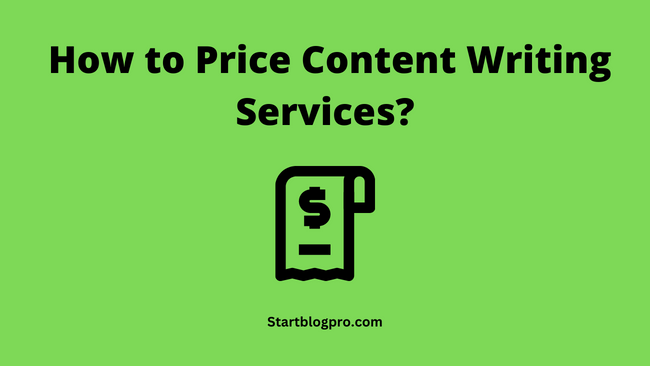Are you passionate about writing? If yes, this guide on becoming a successful content writer is for you.
Content writing involves creating online content. For example, blog posts, articles, social media posts, and more. It’s a creative, flexible and exciting career that allows you to lead a boss-free life.
But how to become a successful content writer?
In this post, we provide the complete procedure for starting a career in content writing. Follow these steps and succeed in content writing.
Before diving deep into content writing. It’s essential to understand the basics of content writing. For example, what is content writing and how does it work?
What is Content Writing?

Content writing is creating written content for digital media. Digital media include websites, blogs, social media, and various other digital channels.
A content writer creates engaging, informative and high-quality content. The purpose of content is to provide information to the reader and solve their problems. He / She persuades the reader to take action.
Skilled content writers use their writing skills and creativity for crafting engaging content. They optimize the content for search engines and social media platforms. Thus, increasing the visibility and traffic of a website or digital platform.
How Content Writing Works?

The process of content writing involves the following steps:
Understand your Audience
The first step is to figure out your target audience. Identify their needs, interests, and pain points. So that you craft the right message for your audience.
Research the Topic
The research involves gathering information about a specific topic. It includes reading books, blogs, and articles. The author may interview experts, conduct polls, and surveys.
Outlining and Planning
After researching, the content writer arranges the information in a logical structure. The outline of the post depends upon how you want to present the information. For example, the outline of a how-to post differs from a listicle post.
Write the Content
Using the outline, start writing the content. Use clear, concise, and simple language in your writing. Match the tone with the purpose of the content and your audience. Do include examples and stats to support your points.
Edit and Proofread
Once you finish your first draft, edit and proofread it. Check for spelling and grammar errors. Look for areas where you can improve the flow and clarity of your writing. Let someone else review the content and provide feedback.
Optimize Content for Search Engines
If you are writing online content, you need to optimize it for search engines. It involves including keywords in the right places in your content. Ensure proper formatting and usage of headings. Content should be easy to read and navigate on digital devices.
Publish and Promote
After the editing process, it’s time to publish the freshly minted content. Promote the content after publishing it to your website or blog.
Use social media, email newsletters, and other channels to drive traffic and engagement.
Next, let us discuss the various content types you can create as a content writer.
What are the Various Types of Content?

As a content writer, you write various types of content. The content types vary depending on the niche, audience, and goals.
Here are some of the most common types of content:
Blog Posts
Blog posts are the most popular type of content. They range from short, news posts to long-form, in-depth articles. The Blog posts have an informal and conversational writing style. They help in engaging and informing the reader.
Articles
Articles are like blog posts, but longer and more formal. They cover a wide range of topics. Magazines, newspapers, and online publications publish articles.
Social Media Posts
Social media posts are short and snappy pieces of content. They are useful for grabbing the reader’s attention and encouraging engagement. Social media posts include text, images, videos, and even links to other content.
Infographics
Infographics are visual representations of information and data. They help simplify complex concepts or data. Thus making it more engaging and accessible to the reader.
Whitepapers
Whitepapers are in-depth reports providing detailed analyses of a specific topic. They are useful in B2B marketing. Whitepapers showcase a company’s expertise.
Case Studies
Case studies are in-depth stories. They showcase how a product/service solved a problem or achieved a specific goal for a customer. Case studies show the value of a company’s products or services.
EBooks
eBooks are long-form pieces of content. They provide in-depth information on a specific topic. Ebooks are often useful as lead magnets that attract and engage potential customers.
Product Descriptions
Product descriptions provide information about a product or service. They highlight a product’s features and benefits. Product descriptions find use in websites, online marketplaces, and marketing materials.
To become a successful content writer, you should explore various content types. Pick the ones relevant to your niche and writing style
How much should Content Writers Charge?

The rates that writers charge vary for each type of content. It depends on factors like a writer’s experience, content complexity and client’s budget.
Here are the rates that writers charge for each type of content.
Blog Posts
$50 – $500 per blog post. The average rate of a 500-word blog post is around $100.
Articles
$100 – $2000 per article. The average rate for a 1000-word article is $500 approx.
Social Media Posts
$25 – $200 per post. The average rate for a social media post is about $100.
Infographics
$200 – $2000 per infographic. The average cost of an infographic is around $800.
Whitepapers
$500 – $5000 per whitepaper. The average cost of a whitepaper is around $3700.
Case Studies
$500 – $2500 per case study. The average rate of a case study is $1500.
EBooks
$500 – $5000 per eBook. The average rate of an eBook is approx $1800.
Product Descriptions
$5 – $50 per product. The average rate for a product description is about $25.
Remember: These rates are general guidelines and vary depending on various factors. As a freelance content writer, it’s important to research rates in your niche.
Choose Content Writing Niche

If you’re starting out as a content writer. You need to find out your content writing niche. There are many niches to choose from. For example, technology, health, beauty, and more.
A niche provides focus to your writing. It helps in creating a powerful brand around the niche. It establishes you as an expert in your field attracting more potential clients.
Here is how to choose a niche for content writing:
Identify your Interests and Passions
Start by making a list of your interests and passions. If you pick something you enjoy, you will stick around longer. It will help you in creating engaging content, as it will reflect in your writing.
Consider your Expertise
List down your experiences, education, or hobbies. It’s unnecessary to be an expert in your niche. But, some knowledge and experience will help you write effectively. You’ll be able to provide valuable insights to your readers.
Research the Market Demand
From the previous steps, you get a list of potential niches. Research the market demand for each of them. What kind of content is already there and how much is the competition? Pick up a niche that has a good balance between demand and competition.
Determine your Target Audience
Write content for a specific target audience. Identify who will be your ideal reader. What are his pain points? What kind of content will solve problems for them? This is how you create content that resonates with your target audience.
As you start writing in your chosen niche. Sometimes, you may find that the niche is not the right fit for you. Don’t be afraid to pivot and try something new. Keep exploring niches, till you find the one that suits you.
Choosing the right niche greatly helps you in becoming a successful content writer.
How to Build Content Writing Portfolio?

As a content writer, building a portfolio showcases your skills and expertise. It helps in attracting potential clients. You can contribute guest posts to popular blogs to build your portfolio. The other way is to volunteer to write for non-profit organizations.
We recommend you start a blog or website. This one step sets you miles apart from your competitors.
Here are the steps to build a portfolio blog or website:
Choose a Platform
There are a ton of platforms for building your portfolio website. Some of the most popular ones are WordPress, Wix, and Squarespace. A self-hosted WordPress is our recommendation.
Select a Domain Name
Choose a short and easy-to-remember domain name. Prefer a name relevant to your niche. Avoid using numbers and symbols in your domain name.
Create a Simple Design
Your website design should be simple and easy to navigate. The colour schemes and fonts should complement each other. Adding to the visual appeal of your website.
Add Home Page
The homepage should showcase your best writing. Display your top 10-15 content pieces in an easy-to-read format. Add images, videos and links to your content. This way your potential client’s view and assess your writing skills.
Create an About Page
Summarize who you are, your background, and your writing experience. Including testimonials from your clients add credibility to your work.
Add Contact Page
The contact page allows your potential clients to reach you. It should include an email address, contact number and social media profiles.
Optimize your Website for Search Engines
Use keywords related to your niche on your website. This allows your potential clients to find you using search engines.
Promote your Website or Blog
Share your website on social media. Join and contribute to online writing communities. The more exposure to your content online. More likely are you to land writing gigs.
Building a website or portfolio blog takes time and effort. It differentiates you from the crowd. It’s a vital step in your content writing journey.
The next thing is to update your website regularly. This will keep the content fresh and engaging.
How to Price your Content Writing Services?

Before you go searching for your potential clients. Ensure that you have your content pricing in place.
Research the industry-standard rates. Create a pricing structure that reflects your skills and experience. Offer packages or retainers to secure long-term clients. This will provide you with a steady stream of income.
Here are some suggested packages you can offer to clients:
Basic Package
- 500 words per article/blog post.
- Basic research and fact-checking
1-2 revisions
Standard Package
- 750 words per article/blog post.
- In-depth research and fact-checking
- 2-3 revisions
- Basic SEO optimization
Premium Package
- 1000 words per article/blog post
- Extensive research and fact-checking
- 3-4 revisions
- Advanced SEO optimization
- Meta descriptions and social media snippets
Finally, create a professional proposal outlining your services, rates, and experience. It should highlight your skills, your niche, and your unique selling points.
How to Find Clients for Content Writing Services?

Finding clients for content writing requires persistence and dedication. You should try different methods. Till you find what works best for you.
Some methods for finding clients for content writing are
Networking
Attend events to connect with people in your niche. The events can be online or offline. Use social media platforms like LinkedIn, Facebook, and Instagram. Join writing groups and take part in forums.
Referrals
Referrals are an excellent way to get clients. Ask your existing customers for referrals. Offer a referral bonus to your existing clients for referring other clients.
Job Boards
Job boards are excellent places for finding potential clients. Some of the popular job boards are, Indeed, Monster, and Glassdoor. They allow you to search for jobs that match your skills.
Cold Pitching
Cold pitching involves reaching out to potential clients without referrals. Here you create a list of potential clients and reach out to them via email or social media.
Freelancing Platforms
Create profiles on freelancing platforms. For example, Upwork, Fiverr, Freelancer, and PeoplePerHour. Show your portfolio skills and start bidding on projects matching your expertise.
Content Marketing
Create and distribute valuable content to attract and keep customers. Create a blog, social media posts, videos, or webinars showcasing your skills.
Guest Posting
Guest posting involves writing articles for other blogs or websites. This helps in building a portfolio and increasing your visibility. Guest posting allows you to reach out to new potential clients.
Networking helps you find clients and build your career as a content writer. Attend writing conferences and join writing groups. Try connecting with other writers and potential clients. Use social media platforms. E.g. LinkedIn, Twitter, or Instagram to promote your writing to your potential clients. You can reach out to businesses, bloggers, or website owners in your niche to pitch your services.
Read: How to Become a Virtual Assistant? A Comprehensive Guide
Conclusion
Becoming a successful content writer is a rewarding and fulfilling career path. It requires hard work, dedication, and passion for writing.
To start your journey, choose a content writing niche. Then build a strong portfolio and network with potential clients. Stay updated with the industry trends and keep improving your writing skills.
With time, effort, and dedication. You can establish yourself as a successful content writer. Enabling you to enjoy the freedom and flexibility of being your own boss. So. start exploring the exciting world of content writing today and see where it takes you.
If you still have questions on how to become a successful content writer. Let me know in the comments below.


![Read more about the article How To Write An Interview Blog Post? [Template Included]](https://startblogpro.com/wp-content/uploads/2022/03/How-to-write-interview-blog-post-1-300x169.jpg)

